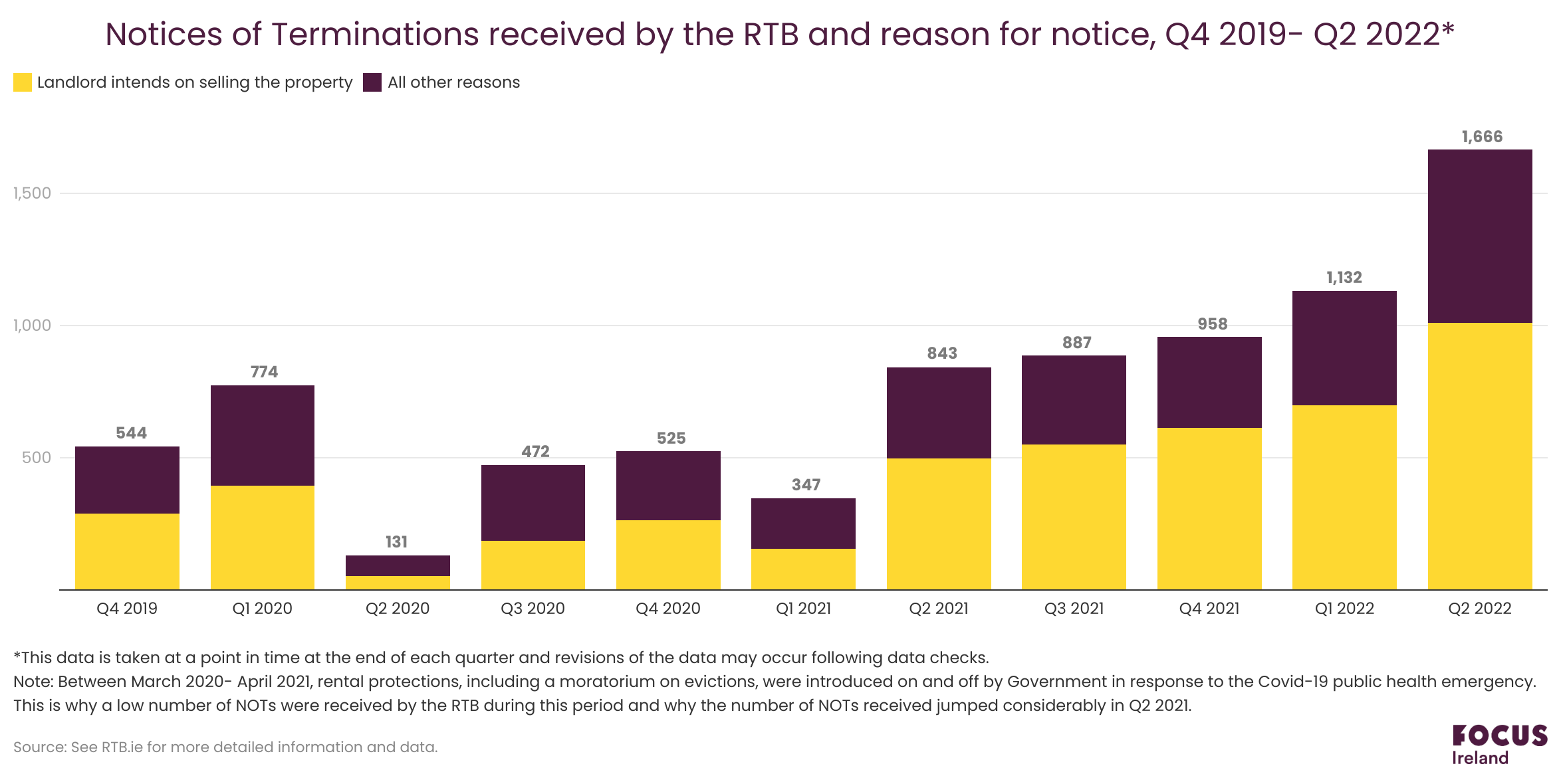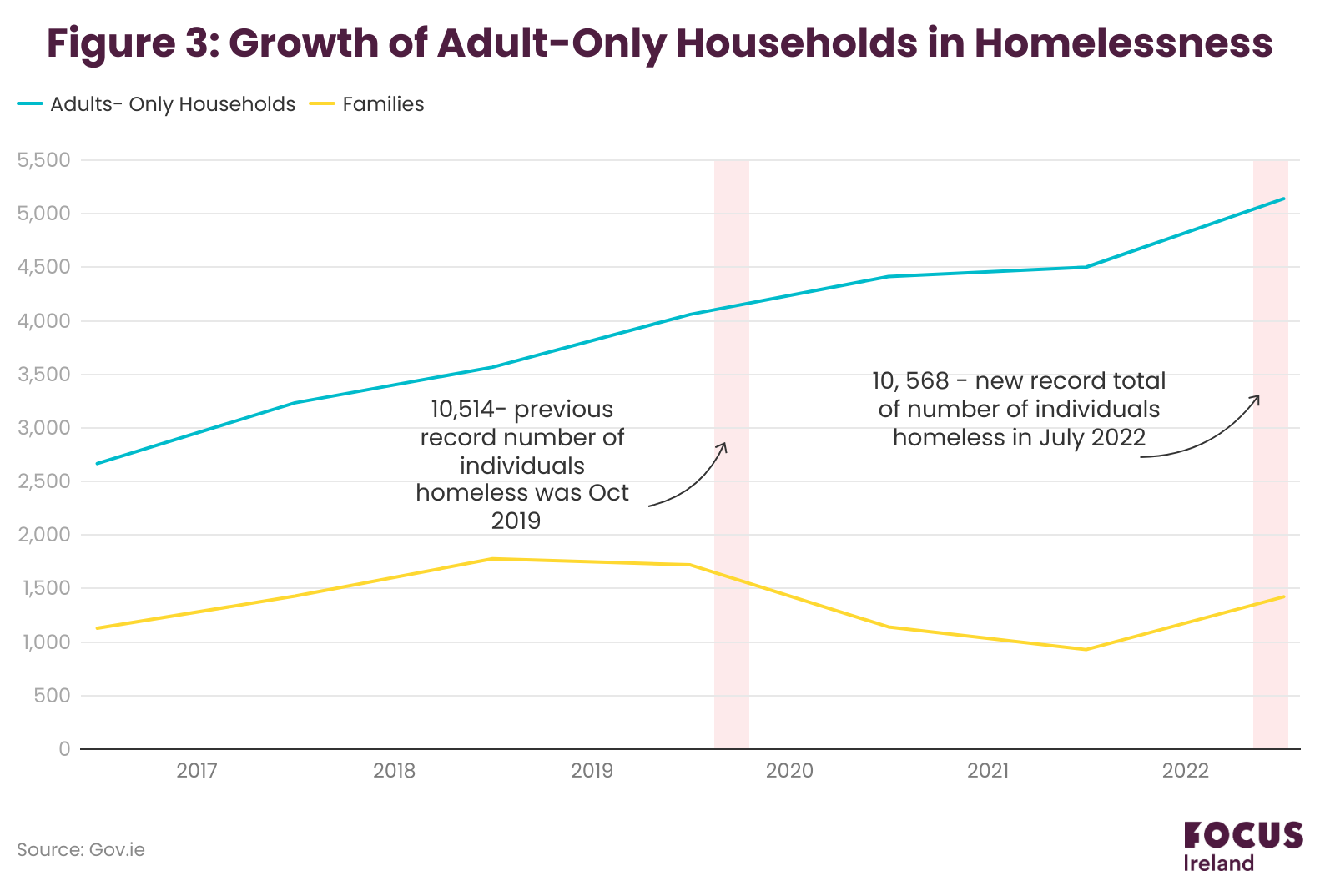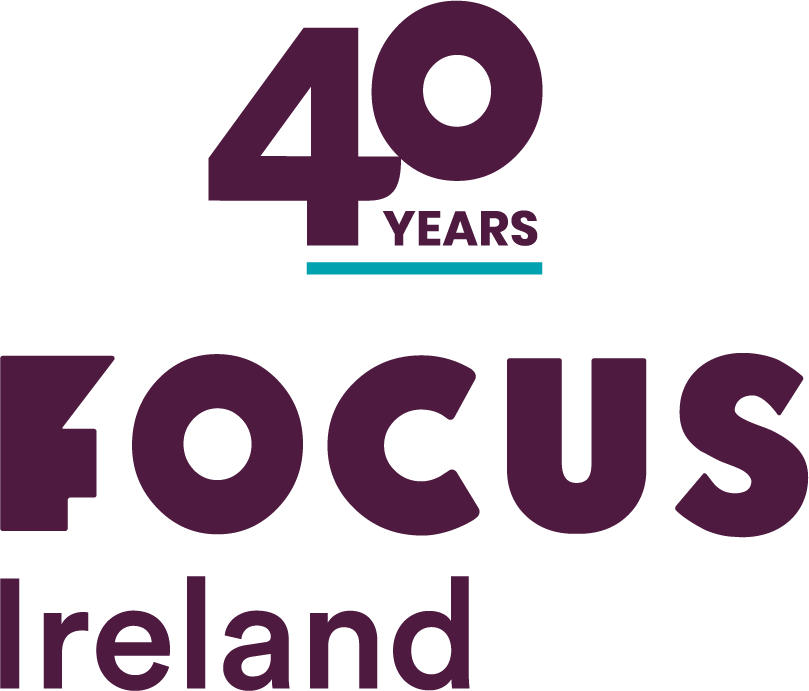Why are the numbers of people homeless at record level and what can be done to stop further increases?
Author: Emma Byrne
The latest official homeless figures show that there were 10,568 individuals in emergency homeless accommodation at the end of July- the highest number of people officially homeless since records began in 2014. This time last year, 8,132 people were being accommodated in emergency accommodation, the latest figures show that number of individuals in homelessness is 30% higher than the same time last year. Family homelessness has more than doubled.[1]
The real number of people who have no home is no doubt considerably higher as local authorities across the country are reporting that every emergency bed is full, and people are being asked to stay temporarily in unsuitable circumstances while new shelters are being commissioned.
This is a stark and worrying increase and demonstrates how quickly a situation can change. The return to pre-pandemic levels of homelessness is extremely disappointing and very concerning given the successes that were achieved at the height of the pandemic when renters were protected from eviction and huge efforts were made to move people out of homeless emergency accommodation with an urgency rarely seen before.
The emergency rental protections that were in place on and off from March 2020 to April 2021 in response to the Covid-19 public health emergency were lifted in April 2021 and evictions began taking place again. The lifting of the moratorium on evictions coincided with slight month-on-month increases in the total number of people in homelessness from May 2021 onwards, however, the number of people in emergency homeless accommodation has been increasing even quicker since the beginning of 2022.
Why are the numbers of people homeless increasing?
Put simply, the number of people officially homeless is rising because there has been a significant reduction this year of the number of individuals exiting emergency accommodation compared to previous years while the number of people presenting to homeless services has remained constant. For example, in Dublin, for each family that left emergency accommodation to a tenancy in July, 2 families entered emergency accommodation, which is driving up the total number of individuals and families in homelessness.[2]
The main reason for the decrease in exits from homelessness is the shortage of private rental accommodation, specifically using HAP, which has heavily been relied on in recent years, making up between 60-70% of exits between 2016-2021. The number of people leaving homelessness for a HAP tenancy in the first half of 2022 was just 20% of the number able to take the same route last year. 394 households exited homelessness using HAP in the first half of 2022, compared with 2,000 households in the first half of 2021.[3] A recent analysis by Simon Communities of Ireland of properties available for rent within HAP rental limits shows that there has been a stark decline in the number of affordable rental properties which is making moving out of homelessness near impossible. Reluctance of landlords to accept HAP tenants also makes it increasingly difficult for people looking to rent what little housing is available with the social housing support. The limited route out of homelessness, combined with new households presenting to homeless services, is driving up the total numbers in emergency homeless accommodation.
Rise in number of pending evictions in 2022
Since the rental protections were lifted in April 2021, there was a significant increase in the number of pending evictions. Data from the RTB, as shown in Figure 2, shows that in Q2 2022 the number of NoTs issued was 98% higher compared to the same quarter last year. The underlying reason for the increase in evictions taking place points to a concerning trend. In Q1 2020, 50% of landlords stated that their reason for eviction was intention to sell, however, this has now increased to 61% in Q2 2022.[4] So, not only are evictions increasing, the number of rental properties available to rent is also reducing which will make it even more difficult for people to avoid entering, and to leave, homeless emergency accommodation.

Source: See RTB.ie for more detailed information and data.
What is different now compared to the previous record level?
In 2018, approximately two thirds of homeless households were adult-only households and around one third were families. The make-up of homeless households now looks very different as the make-up of the number of households officially homeless is made up of a greater proportion of adult-only households, with family and child homelessness lower than the 2019 record level, although this is increasing quicker than adult homelessness. In July 2022, approx. 80% of homeless households are now adult-only and 20% are families.
Figure 3 demonstrates the different make up of households now compared to when there was a previous record number of people homeless in October 2019, compared to the new record just set. This shows that single adult homelessness has never stopped growing, even when the pandemic rental protections were in place and that family homelessness had started to plateau from 2018, decreased at the beginning of the pandemic, and started increasing again from mid-2021. What is more challenging about the current situation compared to the previous 2019 peak is that while the number of individuals is similar, the number of households in homelessness is greater because there are more adult-only households. This means that we will need more housing if we are to reduce this number.

Source: Gov.ie
What measures can help prevent further rises in homelessness?
A further rise in homelessness is not inevitable and a combination of immediate and long-term targeted measures need to be introduced now if we are to stop homeless from rising further and if we are to deliver on our European commitment of ending long-term homelessness by 2030.
Immediate measures:
- Budget 2023 needs to be utilised by Government to incentivise as many landlords as possible to remain in the market for at least 5-7 years, until social housing supply improves. There are an estimated 100,000 households who use some form of State support to rent from private landlords[5] and these households are at a particularly high risk of homelessness if the current trend of landlord leaving the market continues. Focus Ireland has set out 6 key actions that we believe can contribute to stemming the flow of households into homelessness from landlords deciding to evict-to-sell. Read more here.
- The Government needs to temporarily reintroduce the moratorium on evictions that was in place during the Covid-19 pandemic under the emergency powers that are available to the Minister in times of crisis to allow other measures to take effect.
- Households who currently rely on HAP to pay their rent should immediately apply to their Local Authority to increase the amount payable to landlords under the new discretionary powers made available to Local Authorities by Minister O’Brien in July 2022 – they can do that using a new tool developed by Focus Ireland here.
- Research must urgently be conducted into Adult-Only homelessness and why rental protections that were effective at limiting the numbers of families presenting to homeless services was less effective for adult-only households.
Long-Term measures:
- The only long-term solution to ending homelessness in Ireland is a rapid build programme of new social and affordable housing. The reason that our current homelessness and housing crisis exits is because the building of new build social housing ground to a near halt during the austerity years following the Global Financial Crisis. Only a build programme to make up for this shortfall will be successful at ending homelessness.
- The Government’s target is to deliver 9,000 newly built social homes this year but only 639 new build social homes were delivered in in the first quarter of the year[6] and the figures for the second quarter have not been published at time of writing.
- Increasing the supply of social housing will continue to face very serious challenges given the continuing effects of Covid-19, and its impact on construction supply chains, the fallout from Brexit, rising inflation costs, interest rate rises, the cost-of-living crisis, and wider geopolitical uncertainty. All barriers to construction must be removed, and flexibility and innovative thinking will be required by Local Authorities and Government if the goal of delivering 90,000 new build social homes by 2030 is to be met.
- It is essential that as well as delivering more housing we are delivering the right kind of housing. Most households on the social housing waiting list only require 1-bed homes and most households in homelessness are single adults. Specific targets must be set, and plans must be developed by the Department of Housing to increase the delivery of 1-bed units.
- With over 25% of households now privately renting, many with state support, a strategy needs to be developed and implemented to build a more stable, secure and affordable rental sector which would give certainty to both tenants and landlords.
[1] https://www.gov.ie/en/publication/7d630-homeless-report-july-2022/
[2] https://www.homelessdublin.ie/content/files/DRHE-Monthly-Report-July-2022.pdf
[3] https://assets.gov.ie/230948/ae193306-0fd3-4699-8860-8e4d30201b80.pdf
[4] https://www.rtb.ie/data-hub
[5] ESRI (2022) https://www.esri.ie/system/files/publications/RS141_1.pdf
[6] Social Housing Delivery by Area Q1 2022– https://assets.gov.ie/228797/00abd099-4f73-4cfb-a1f9-b9491b982796.xlsx
Focus Blog
16 Days of Activism: Interactions Between Homelessness and Domestic Violence
As part of the 2025 16 Days of Activism Against Gender Based Violence, this blog examines how homelessness and domestic violence intersect along a continuum of harm. The continuum begins with abuse itself, but for many women in Ireland, leaving an abusive relationship does not mark a transition to safety. Instead, harm often changes form. Homelessness and systemic barriers can prolong trauma long after the initial physical violence stops.
Childcare is an essential support for lone parents experiencing homelessness
Childcare is a significant issue for many families in Ireland in 2025. Affordability, capacity, staff shortages and long waiting lists are widely reported and the situation is often described as a childcare crisis.
What does the expenditure on homelessness tell us about the our approach to tackling homelessness?
Despite its technical title, the Focus on Homelessness report “Public Expenditure on Services for Households Experiencing Homelessness” (March 2025), paints a vivid picture of how we have responded to the enduring homelessness crisis over the last decade. The picture it paints is not one driven by vision or ideology, but rather a reactive response which constantly underestimates the scale of the challenge and consumes resources trying to contain, rather than solve, the problem. It also provides hints about what we could do better.
Minister should rethink proposal to remove ‘no fault eviction’ safety net
Minister for Housing, James Browne, has proposed changes to the‘Tenant in situ’ scheme which, while he presents them as ‘refocusing on families’ and ‘new funding’, in reality, will take away the safety net from people facing homelessness due to ‘no-fault evictions. Focus Ireland has written to the Minister, asking him to reconsider the proposal.
What is Youth Homelessness?
Youth homelessness means people aged 13 -26 who are without stable accommodation and staying in hostels, temporary accommodation, couch surfing or rough sleeping. They are facing homelessness at a crucial point in their emotional, cognitive and social development while transitioning from adolescence to adulthood
Where do potential Coalition partners stand on homelessness?
Housing and homelessness was the most important issue for most people in last Friday’s general election, according to Irish Times/RTÉ/TG4/TCD exit poll, with 29% of voters saying that it was their top issue when voting. With all seats now filled, and several potential coalition outcomes now possible, negotiations around housing will likely be one of the deciding factors on whether parties choose to form a coalition government together over the next few weeks.
Non stop increase in adult-only homelessness over last decade shows we need a serious rethink
Our new report shows that adult-only homelessness has been allowed to steadily increase, year on year since 2014, we now have triple the number of homeless adult-only households than we did just a decade ago.
Youth Homelessness: An Obvious Opportunity for Homelessness Prevention
To mark UN International Youth Day, this blog post takes a look at this youth homelessness from the perspective of homelessness prevention. If we wish to truly end homelessness, as we have committed to working towards by 2030, then we must prevent youth homelessness.
Shining a spotlight on women’s homelessness this #IWD2023
On International Women’s Day 2023, Focus Ireland reflects on the current state of women’s homelessness in Ireland and highlights the importance of developing services and policy responses that respond better to the unique needs and experiences of women. This is even more urgent than ever as figures show a 49% rise in the number of women homeless in the last two years.
The winter eviction ban and homelessness: early evidence
The Government’s hasty introduction of a Winter Eviction Ban has failed to halt the rise in the total number of individuals in homelessness so far. The November 2022 homeless figures are the first to reflect the impact of the ban, which came into force at the start of the month but, rather than the decrease that some had predicted, they showed a further increase of 145 to yet another new record level.
An international perspective on Irish homelessness policy
‘From Rebuilding Ireland to Housing for All: international and Irish lessons for tackling homelessness’ was launched in September this year, receiving widespread positive coverage. Here we asked the lead researcher, Professor Nicholas Pleace of York University, to write a guest blog, setting out the main conclusions from the project.
Causes of Family Homelessness in the Dublin Region during the Covid-19 Pandemic
While Covid-19 supended life as know it in 2020, this global disaster has been slowly but surely subsiding. With the roll-out of new vaccines, economies, and societies, have reopened. However, one of the more problematic issues pre-Covid, the use of emergency accommodation to house people experiencing homelessness, is again being used at a much higher rate in the last year.
Why are the numbers of people homeless at record level and what can be done to stop further increases?
With homelessness reaching a new record level in July, this blog looks at why homelessness has risen by 30% in the last year and what immediate and long-term actions must be taken now if we are to stop homeless from rising further.
Solidarity with Young People, Challenging Youth Homelessness: Focus Ireland Youth Services and Advocacy
In recognition of UN International Youth Day, this blog will highlight the risks faced by certain young people in terms of homelessness and housing insecurity, and the supports and services Focus Ireland is providing to address them.
Understanding housing inequalities: The disproportionate risk of homelessness facing migrants living in Ireland
March 2022 saw a sharp rise in the proportion of people with European Union or European Economic Area (EU/EEA) citizenship newly presenting to homeless services, according to figures reported by the Dublin Regional Homeless Executive (DRHE). The increase sparked media speculation concerning the causes of this, the role played by migration, and the implications of this apparent trend for homeless services and the housing sector in general. However, the most recent DRHE Monthly Report to Dublin City Councillors on Homelessness shows that the proportion of new presentations from persons with EU/EEA citizenship markedly fell to a more typical level in April.
Welcome decrease in rough sleeping as adult-only homelessness at record level in Dublin
There was a welcomed slight decrease in the number of individuals found rough sleeping in Dublin in Spring 2022 according to figures published by the Dublin Region Homeless Executive (DRHE) last week . The Official Spring Count of people sleeping rough in the Dublin Region was carried out over the week March 28th – April 3rd and identified a total of 91 individuals confirmed as rough sleeping during the week.
Review of 7 years of spending on homelessness shows it’s time to change
In the first Special Edition of our Focus on Homelessness series, we are looking at Expenditure on Services for Households Experiencing Homelessness. In this blog post, Director of Advocacy Mike Allen outlines why we need a deeper understanding of this, and how this Edition does this.
Why we need an inclusive High Road Covid-Era Back to Work Strategy
In the space of just a few weeks, Covid-19 has fundamentally reconfigured the relationship between welfare and work in Ireland. In this blog post, Dr Mary Murphy, Senior Lecturer at Maynooth University, examines why we need an inclusive high road back to work strategy as we transition out of the Covid-19 pandemic.
Covid-19 and building a society where we can all have a home to stay put in
The Covid-19 pandemic puts people who are homeless at risk disproportionate risk – not only are they more likely to have underlying health issues, they are unable to follow the key recommendations –wash your hands regularly, stay at home and keep a ‘social distance’ from other people.
Understanding the December 2019 homeless figures – Part 1
Having access to accurate numbers is key to informing policy and services responses designed to tackle homelessness. It is equally vital to have the information behind the numbers to be able to clearly understand trends as they develop.


